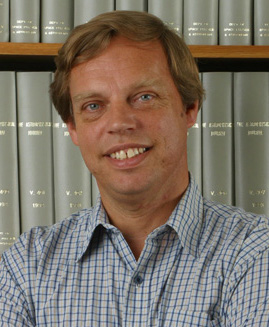Feb 16 2016
A new realm of discovery opened last week with the unequivocal proof that gravitational waves exist.
These waves, a form of radiation, were until now the last unconfirmed prediction of Albert Einstein’s theory of general relativity.
 Matthew Baring. Photo by Tim Taylor
Matthew Baring. Photo by Tim Taylor
One hundred years after the publication of Einstein’s theory and 40 years after the quest began in earnest, the National Science Foundation announced Feb. 11 that the Laser Interferometer Gravitational-Wave Observatory (LIGO) experiment found evidence of gravitational waves emitted by two black holes that collided in a distant galaxy 1.3 billion years ago.
Scientists had indirectly proven the existence of gravitational waves through their observation of an inspiralling neutron star binary, which led to a Nobel Prize in physics for astrophysicists Russell Hulse and Joseph Taylor in 1993. (Coincidentally, they made their discovery in 1974 at the Arecibo radio telescope founded by former Rice University Provost William Gordon.)
Data from their discovery, and also those of other such binary systems, has led to precise determinations of neutron star masses. These neutron star binaries contain pulsars, lighthouses in the sky that are among the most accurate timekeepers in the universe. Researchers have observed periodic orbital variations in the arrival times of their ticks and determined that they matched Einstein’s prediction of how gravitational waves would affect such a signal by slowly shrinking the orbits of the binaries.
Now detecting the waves directly has sealed the deal for Einstein’s theory of gravity, which has proven robust in every other way and is needed for accuracy in technology like GPS.
It’s no surprise that LIGO picked up the signature of two black holes merging, since the wave would be much stronger, typically by at least two to three orders of magnitude, than that from the merger of two neutron stars.
In principle, the temporal oscillation of black hole-black hole gravity wave signals should be much cleaner than those from other types of collisions. Both black holes have a fixed boundary — the event horizon — and generally there is no spatial distribution of matter just outside of its radius, when they do not spin. That is not the case for neutron stars.
Simulations of black hole mergers showed very clean oscillations in the signal indicating a gravitational wave, rising rapidly, and then ringing in a decaying tail after the merger has taken place – exactly as seen in the data taken by LIGO facilities in Louisiana and Washington state. The period and the shape of the oscillation provided information on the total mass of the two black holes and their mass ratio, as well as a general location in the sky for the event.
This very clean time signature affords precise diagnostics on mass. For the merger of two neutron stars, the distribution of matter outside the event horizon is (a) not well-known, since it depends on the type of nuclear matter inside the stars, and (b) would lead to moderate or even significant smearing of the oscillation as matter is accreted (or falls in) through the final event horizon in a continuous (but short-lived) stream.
If the LIGO discovery is eventually confirmed via other such detections, it too will likely garner a Nobel Prize in physics.
In the long term, the discovery will establish the classical theory of general relativity on a complete footing. It may diminish the interest of the physics community in alternative theories of gravity, which have been invoked to explain dynamical signatures in our galaxy and beyond as an alternative to inferring the presence of dark matter.
On the other hand, it will add profoundly to our confidence in the existence of gravity waves. That will underpin future understanding of their quantized version, gravitons, which can ultimately propel scientists’ ability to develop a theory of quantum gravity and eventually unify all the fundamental forces of nature. It will also assist in discerning the character of the universe when it was very young, well before stars and galaxies and even atoms had formed.
My own research, and that of my Rice colleagues, cosmologist Mustafa Amin and astrophysicist Edison Liang, will be profoundly affected by this new window into the universe.
As a member of the Fermi Large Area Telescope collaboration, I explore models of gamma ray bursts (GRBs) that may be produced by colliding black holes and neutron stars. This, the world’s premier gamma-ray telescope, has seen many such bursts since operations began in 2008. As these GRBs may also produce gravitational waves, we’ll now combine the efforts of LIGO, Italy’s upcoming VIRGO gravitational wave detector and telescopes that see in other wavelengths to pinpoint the locations and learn the natures of these cataclysmic cosmic events. Things move quickly: There is already an indication of a weak gamma-ray signal associated with the LIGO event in both space and time, obtained by the Fermi Gamma-Ray Burst Monitor. What will we discover next?
The LIGO era is here at last. For astronomers, astrophysicists and, really, anyone who looks skyward to appreciate the beauty of the cosmos, it’s a wonderful time to be alive.
Matthew Baring is a Rice professor of physics and astronomy.